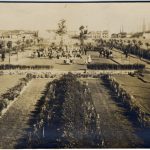Discovering Ostrava´s parks - a view to the history
 Nature and Biodiversity
Nature and Biodiversity
People have always enjoyed spending time in parks and gardens – calm green oases amid the hectic stress of everyday life. Each historical period has had its own unique approach to designing parks and gardens – whether as part of chateaux, monasteries, or urban spaces. The industrial revolution brought a boom in urban populations, and the new cities built public parks and gardens as places where all citizens could enjoy spending their leisure time. Cities often created parks in the spaces left behind after demolishing former city walls, or on the sites of former cemeteries. Parks often featured bandstands, summerhouses and gazebos, as well as facilities for sports and leisure.
Altough Ostrava began to grow into a major industrial city in the early 19th century, for many years it lagged behind its neighbours with regard to parks and green areas. It was not until 1852 that the first park was created in Ostrava; a local sports shooting club bought an area of wild land on the right bank of the Ostravice River where it built a shooting range, planted trees and shrubs, laid out paths and installed benches. This park quickly became a popular place for people to meet and relax.
- The park at the former shooting gallery in Moravská Ostrava, postcard from 1910.
- Božena Němcová Park in Přívoz (1920).
- The Emperor Joseph Park (today Husův Sad) in the city centre, photograph from the late 19th century. In the background is the Chapel of St Elizabeth, built in 1898 in memory of the Empress Elisabeth (Sissi), the wife of Franz Joseph I.
- The Komenského Sady park in the 1930s.
- Smetana Park in Mariánské Hory, where a memorial to composer Bedřich Smetana was unveiled in 1924. The only part of the park still surviving is in Karla Tomana Street.
A smaller park – named after the German poet Friedrich Schiller – was created at the end of the 19th century on a site where the Moravská Ostrava town hall now stands. In 1891-2 work began on a new park stretching along the left bank of the Osravice, which is now known as Komenského Sady (´Comenius Gardens´). In 1907 the city council decided to extend the park and create sports and entertainment facilities. When the New City Hall was built in the late 1920s, an ambitious project was launched to revitalize the park. The work continued from 1928 into the next decade; the park grew from its original 7 hectares to 32, making it one of the largerst parks in the country.
In the early 20th century the town of Přívoz created a park (now named after the Czech author Božena Němcová) on the site of a former metal factory. The park was designed by the Opava-based Skazik company, which in 1907 also planned the riverside park that later became Komenského Sady.
Vítkovice also has a large park, created in 1922 on the site of a former cemetery; it now bears the name of the journalist and author Jožka Jabůrková, and its mini-zoo makes it a popular family destination. In 1905 a park named after the Emperor Franz Joseph was built on the site another cemetery in Vítkovice. In 1936 a bus of the Catalan anarchist thinker Francesco Ferrer Guardia was installed in the gazebo. The park was located between today´s Halasova and Šalamounova Streets.
Other park were created on the sites of former cemeteries or at chateaux and coutry houses in Třebovice, Poruba, Kunčice, Polanka and Bartovice.







